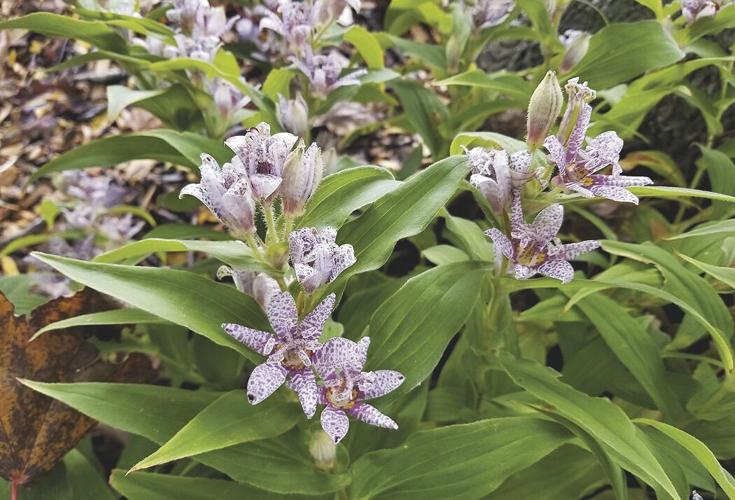Being called a toad is not exactly a compliment. The amphibious creature that we are all familiar with has warty skin that can exude poison. Calling a person a toad implies that they are contemptible or detestable, according to the Oxford dictionary.
Does that definition carry over to plants as well? Plants of the genus Tricyrtis are often called toadlilies. The most common explanation for the name toadlily is that the flowers and leaves are spotted like toads. Also, the flowers have warty, sack-like (saccate) bumps at the base of the flowers that some think mimics the skin of a toad. These bumps are known as nectaries and, in my opinion, are far removed from toad skin in appearance.
Personally, I like the Japanese name for Tricyrtis, which is hototogisu, the name for a shy forestdwelling bird. Even the “lily” part of the common name is a bit misleading. Tricyrtis is in the Liliaceae, the lily family, but true lilies are in the genus Lilium. Tricyrtis may be shy, but it’s a powerhouse in the fall garden.
Toadlilies are shade-loving herbaceous perennials native from the Himalayas to East Asia, including China, Japan, Taiwan and the Philippines. They are found on shady, rocky cliffs and stream banks, and along the edges of forests. Tricyrtis is almost always found where rainfall is plentiful, though I have found them to be quite drought tolerant once established.
The genus consists of about 20 species, but most plants in commerce are either Tricyrtis formosana or Tricyrtis hirta, or hybrids of the two. Other species may not be hardy in Wisconsin.
Tricyrtis hirta, the hairy toadlily, is the most cold hardy species of the genus. As the name implies, leaves are hairy, arranged ladderlike along unbranched stems. It spreads slowly to form a clump.

Glenn Herold
Flowers have a white or pale purple back color and are covered with darker purple spots and blotches. They are between 1 and 1 1/2 inches wide and have the appearance of an orchid flower. Bloom time is from mid-September to mid-October. Because of the small flower size and detailed coloration, they are best used where they may be viewed close up. Hairy toadlily varies in height from 1 to 3 feet.
Tricyrtis formosana, the Formosa toadlily, is not as cold hardy as Tricyrtis hirta, but readily hybridizes with it, resulting in numerous cultivars that are reliably hardy in southern Wisconsin.
Unlike the hairy toadlily, it spreads with lateral stems to form a colony, but not so rapidly that it is invasive. Flowers open over a longer period of time than Tricyrtis hirta, usually continuing until a hard frost ceases flower production.
While purple is the normal flower color, Tricyrtis macrantha is a species with yellow flowers. Unfortunately, it is only hardy to Zone 6, making it less than reliable even in southeast Wisconsin. If you can plant it in a protected area, though, the striking flowers make it worth trying.
I grow five cultivars of Tricyrtis in my garden. Tricyrtis “Miyazaki” is about 18 inches tall and has purple flowers with white spots. It is very floriferous and was a top pick in trials at the Chicago Botanic Garden.
Some list it as a cultivar of Tricyritis hirta, while others consider it a hybrid with Tricyrtis formosana. “Blue Wonder” is a hybrid with flowers that are light purple with darker purple spots.
Tricyrtis “Tojen,” another hybrid, has leaves that are larger than the typical Toad Lily. The orchid-lavender flowers are mostly terminal, rather than in the axils of the leaves, and are unspotted. Bright green leaves are contrasted with burgundy stems.
“Lightning Strike” has golden foliage streaked with green. Lavender flowers are produced at the top of 2-foottall stems. My most recent acquisition is Tricyrits formosana “Autumn Glow.” A wide yellow margin on the dark green leaves makes it a standout in the garden.
A cultivar that I don’t grow, but have been impressed with in other locations, is “White Lightening,” a cultivar of Tricyrtis hirta. It is a vigorous, upright grower with pure white flower all along the stems in the axils of the leaves. The white flowers are a beacon in the shade garden. Toadlily is a great companion for hostas, ferns, astilbe, hellebores, heuchera and spring blooming wildflowers. It is resistant to deer browsing, but rabbits may find new shoots to their liking.
For a fall blooming shade plant, it can’t be beat.
Cedarburg resident Glenn Herold was professor of horticulture at Illinois Central College, East Peoria, IL from 1979 to 2011. He earned his BS in biology and MS in horticulture from the University of Wisconsin-Madison. Currently he holds memberships in the Midwest Regional Hosta Society, American Hosta Society, American Conifer Society, The Maple Society, Wisconsin Woody Plant Society, and Wisconsin Hardy Plant Society. Anyone with questions or comments, can email Glenn at PlantmanGlenn@gmail.com. Additional articles on plants and gardening can be found on my blog: https://TheCottageGardener53012.Wordpress.com.















